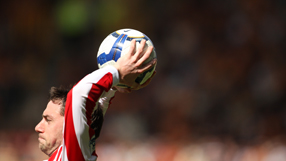Footballers unite to tackle back pain
Stoke City's Rory Delap, renowned for his devastating throw-in, has joined forces with Frank Leboeuf and Thomas Helmer to support ‘Back in Play’ - a European wide campaign to raise awareness of ankylosing spondylitis (AS), a poorly understood condition which can affect the lower back.

AS is a type of inflammatory arthritis, characterised by low back pain and stiffness, which is most common in young men.
The symptoms can be subtle and are often overlooked or confused with common back pain or sports injuries meaning it can take as long as 3-11 years to be accurately diagnosed.
The campaign, supported by the Ankylosing Spondylitis International Federation (ASIF,) kicks off with the launch of the Back in Play website, www.back-in-play.com.
The site is home to an addictive football game with a competitive European league, which tests a player’s throw-in skills whilst highlighting the symptoms of AS that can differentiate it from other back pain.
In addition to watching a throw-in master class from Delap, visitors to the site can review the symptom checklist compiled by ASIF, find out more information about the condition via patient and doctor interviews and links to patient support groups.
Delap, whose flexibility and back strength is key to his enviable skill, believes Back in Play can help raise awareness of this relatively unknown condition and its symptoms.
Lending his personal support to the initiative, Delap said: "Most football fans will not have heard about AS, yet the stats show up to 1 in 200 will have it.
The best features, fun and footballing quizzes, straight to your inbox every week.
"It is understandable that some of the symptoms like lower back pain are often written off as a sports injury or bad posture, however there are some key subtleties such as the pain getting better with exercise and painful, red eyes, that can indicate AS. Test your throw-in skills with the game and check out the symptoms at the same time."
Most commonly, but not exclusively found in young men, AS symptoms typically start in the late teens and early twenties, causing severe, chronic pain and discomfort.
"A lack of awareness of the condition and the gradual onset of symptoms means that it can take years for sufferers to get an accurate diagnosis, I believe 15 years in my own case," said Seoirse Smith, President of the Ankylosing Spondylitis International Federation (ASIF).
"I know from personal experience that the earlier the condition is diagnosed the better the outcome for the patient. If AS is not correctly diagnosed or treated, over many years, the spine can become rigid as it may fuse together, and fixed in a bent position making it increasingly difficult to move around freely and undertake day-to-day activities with ease."
Although there is no cure for AS, Professor Désirée van der Heijde, from the Department of Rheumatology at the Leiden University Medical Center in Leiden, Holland, says patients can be managed effectively.
"There are a number of treatment options available to help reduce the pain and stiffness experienced by sufferers, from traditional anti-inflammatory drugs which are usually the first line of treatment, to the newer biologics.
"In addition to taking medication, maintaining a good posture and a regular exercise routine has also been proved to be beneficial."
Gregg Davies is the Chief Sub Editor of FourFourTwo magazine, joining the team in January 2008 and spending seven years working on the website. He supports non-league behemoths Hereford and commentates on Bulls matches for Radio Hereford FC. His passions include chocolate hobnobs and attempting to shoehorn Ronnie Radford into any office conversation.

